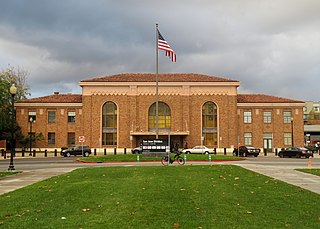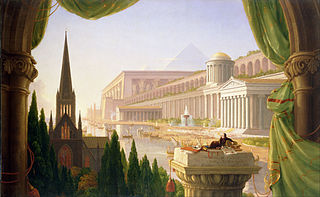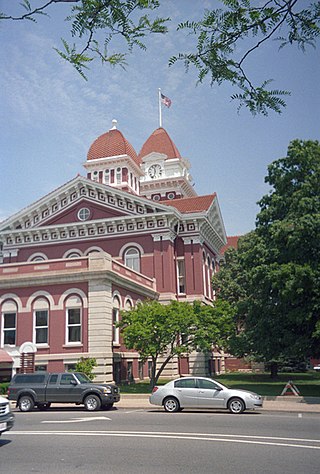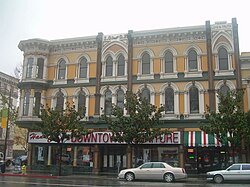
Victorian architecture is a series of architectural revival styles in the mid-to-late 19th century. Victorian refers to the reign of Queen Victoria (1837–1901), called the Victorian era, during which period the styles known as Victorian were used in construction. However, many elements of what is typically termed "Victorian" architecture did not become popular until later in Victoria's reign, roughly from 1850 and later. The styles often included interpretations and eclectic revivals of historic styles (see Historicism). The name represents the British and French custom of naming architectural styles for a reigning monarch. Within this naming and classification scheme, it followed Georgian architecture and later Regency architecture and was succeeded by Edwardian architecture.

The Fan is a district of Richmond, Virginia, so named because of the "fan" shape of the array of streets that extend west from Belvidere Street, on the eastern edge of Monroe Park, westward to Arthur Ashe Boulevard. However, the streets rapidly resemble a grid after they go through what is now Virginia Commonwealth University. The Fan is one of the easterly points of the city's West End section, and is bordered to the north by Broad Street and to the south by VA 195, although the Fan District Association considers the southern border to be the properties abutting the south side of Main Street. The western side is sometimes called the Upper Fan and the eastern side the Lower Fan, though confusingly the Uptown district is located near VCU in the Lower Fan. Many cafes and locally owned restaurants are located here, as well as historic Monument Avenue, a boulevard formerly featuring statuary of the Civil War's Confederate president and generals. The only current statue is a more modern one of tennis icon Arthur Ashe. Development of the Fan district was strongly influenced by the City Beautiful movement of the late 19th century.

The Alameda is a historic district of Central San Jose, California, west of Downtown San Jose. The district is centered on an alameda, a historic portion of El Camino Real connecting Downtown San Jose to Mission Santa Clara de Asís, and includes the smaller, surrounding neighborhoods to the north and east, like College Park and St. Leo's.

San Jose Diridon station is the central passenger rail depot for San Jose, California. It also serves as a major intermodal transit center for Santa Clara County and Silicon Valley. The station is named after former Santa Clara County Supervisor Rod Diridon Sr.

The Hotel De Anza is a historic hotel in San Jose, California. At ten stories, it once was the tallest hotel in the San Jose central business district, prior to the construction of Hilton, Fairmont, and Marriott hotels. Significant for its architectural style, it is one of San Jose's few Zig Zag Moderne buildings. The hotel was listed on the National Register of Historic Places on January 21, 1982.
San Jose, California, is the third largest city in the state, and the largest of all cities in the San Francisco Bay Area and Northern California, with a population of 1,021,795.

Historicism or historism comprises artistic styles that draw their inspiration from recreating historic styles or imitating the work of historic artists and artisans. This is especially common in architecture, where there are many different styles of Revival architecture, which dominated large buildings in the 19th century. Through a combination of different styles or the implementation of new elements, historicism can create completely different aesthetics than former styles. Thus, it offers a great variety of possible designs.

Architectural revivalism is the use of elements that echo the style of a previous architectural era that have or had fallen into disuse or abeyance between their heyday and period of revival. Revivalism, in a narrower sense, refers to the period of and movement within Western architectural history during which a succession of antecedent and reminiscent styles were taken to by architects, roughly from the mid-18th century, and which was itself succeeded by Modernism around the late 19th and early 20th centuries. Notable revival styles include Neoclassical architecture, and Gothic Revival. Revivalism is related to historicism.

Crown Point Courthouse Square Historic District is a historic district in Crown Point, Indiana, that dates back to 1873. It was listed on the National Register of Historic Places in 2004. Its boundaries were changed in 2005, and it was increased in 2007 to include a Moderne architecture building at 208 Main Street. The late nineteenth- and early twentieth-century commercial and public buildings represent a period of economic and political growth. The Lake County Courthouse stands in the center of the district. Designed by architect John C. Cochrane in 1878, this brick building is a combination of Romanesque Revival and Classical styles. Enlarged in 1909 with the addition of north and south wings, designed by Beers and Beers. Continued growth in the county required second enlargement in 1928. This local landmark was placed in the National Register of Historic Places in 1973.

Valparaiso has retained an active downtown. It remains a mix of government, retail and business center, with a mixed residential and service area. Numerous economic changes have not changed the basic character, historic courthouse area. The historic district retains the distinctive turn-of-the-19th-century architecture, supporting numerous small specialty shops, shaded sidewalks, and a people friendly environment. The Downtown District, is anchored on the Porter County Courthouse. It includes 14-blocks surrounding the square, bounded on the north by Jefferson Street, on the east by Morgan Street, on the south by Monroe Street, and on the west by Napoleon Street.

The Downtown Gloversville Historic District is a national historic district located in Gloversville, Fulton County, New York. It is roughly bounded by Spring, Prospect, West and East Fulton, North and South Main, and Elm Streets.
In the United States, the National Register of Historic Places classifies its listings by various types of architecture. Listed properties often are given one or more of 40 standard architectural style classifications that appear in the National Register Information System (NRIS) database. Other properties are given a custom architectural description with "vernacular" or other qualifiers, and others have no style classification. Many National Register-listed properties do not fit into the several categories listed here, or they fit into more specialized subcategories.

The Mission Revival style was part of an architectural movement, beginning in the late 19th century, for the revival and reinterpretation of American colonial styles. Mission Revival drew inspiration from the late 18th and early 19th century Spanish missions in California. It is sometimes termed California Mission Revival, particularly when used elsewhere, such as in New Mexico and Texas which have their own unique regional architectural styles. In Australia, the style is known as Spanish Mission.

Oak Hill Memorial Park is a cemetery in San Jose, California, United States. Founded in 1847, it is the oldest secular cemetery in California. Oak Hill is the northernmost hill in the San Juan Bautista Hills of South San Jose.

Plymouth Downtown Historic District is a national historic district located in Plymouth, Marshall County, Indiana, United States. The district encompasses 47 contributing buildings and one contributing structure in the central business district of Plymouth. It developed between about 1870 and 1940, and includes examples of Italianate, Romanesque Revival, and Colonial Revival style architecture. Located in the district is the separately listed Plymouth Fire Station. Other notable buildings include the Montgomery Ward Building (1929), Metsker Block, Rentschler Building (1910), Early Plymouth Post Office (1884), First National Bank-Plymouth City Hall, Packard Bank Block (1879), Simons Building (1895), Wheeler Block, Bank Block, Bank Block-Masonic Temple (1901), Plymouth Post Office (1935), and Plymouth Motor Sales (1929).

Sarah L. Knox-Goodrich was a women's rights activist who worked for women's suffrage in California in the late nineteenth century. Her first husband, William Knox, was a business man, banker, and state politician. Her second husband, Levi Goodrich, was an architect in Southern California. Knox-Goodrich used her wealth and her social position to push for equal employment, school suffrage, and voting rights.

The Downtown Commercial District in Lexington, Kentucky, includes 70 contributing properties, some dating from the early 19th century. Most sites are commercial buildings, but the district also features a courthouse, two monuments, a camel sculpture, a drinking fountain, and a clock. Various architectural styles are represented, including Federal, Greek Revival, Italianate, Victorian, Queen Anne, Richardsonian Romanesque, Beaux Arts, and Modern. Architects include Gideon Shryock, Benjamin Henry Latrobe, H.L. Rowe, Frankel & Curtis, and McKim, Mead & White. Also included within the district are 17 noncontributing properties. The Downtown Commercial District was added to the National Register of Historic Places in 1983.

The Okmulgee Downtown Historic District is the original downtown area of Okmulgee, Oklahoma, roughly bounded by 4th Street, 8th Street, Okmulgee Avenue, and the Frisco tracks. It was added to the National Register of Historic Places on December 17, 1992.
Levi Goodrich (1822–1887) was an American architect based in San Jose, California. His most notable projects include San Jose City Hall, Santa Clara County Courthouse, San Jose City Hall, and California State Normal School. Goodrich's wife, Sarah Knox-Goodrich, was a well known activist who worked for women's suffrage in California.

The Hensley Historic District, also known as Northside Residential District, is a U.S. historic district and residential neighborhood in San Jose, California. The neighborhood is northeast of downtown and is roughly bounded by East Julian Street, North 1st Street, North 7th Street, and East Empire Street. It is listed as a California Historical Landmark since June 21, 1983; and is listed as one of the National Register of Historic Places (NRHP) since June 21, 1983.






















